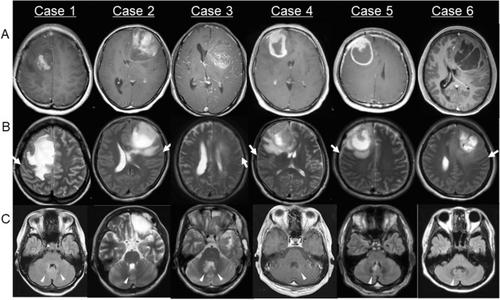Acta Neurochirurgica ( IF 1.9 ) Pub Date : 2024-02-14 , DOI: 10.1007/s00701-024-05981-8
Masayuki Kanamori 1 , Yohei Morishita 2 , Yoshiteru Shimoda 1 , Eiko Yamamori 2 , Shiho Sato 2 , Yoshinari Osada 1 , Shin-Ichiro Osawa 1 , Ichiyo Shibahara 3 , Ryuta Saito 4 , Yukihiko Sonoda 5 , Toshihiro Kumabe 3 , Hidenori Endo 1

|
Background
Distant recurrence can occur by infiltration along white matter tracts or dissemination through the cerebrospinal fluid (CSF). This study aimed to clarify the clinical features and mechanisms of recurrence in the dentate nucleus (DN) in patients with supratentorial gliomas. Based on the review of our patients, we verified the hypothesis that distant DN recurrence from a supratentorial lesion occurs through the dentato-rubro-thalamo-cortical (DRTC) pathway.
Methods
A total of 380 patients with supratentorial astrocytoma, isocitrate dehydrogenase (IDH)-mutant (astrocytoma), oligodendroglioma, IDH mutant and 1p/19q-codeleted (oligodendroglioma), glioblastoma, IDH-wild type (GB), and thalamic diffuse midline glioma, H3 K27-altered (DMG), who underwent tumor resection at our department from 2009 to 2022 were included in this study. Recurrence patterns were reviewed. Additionally, clinical features and magnetic resonance imaging findings before treatment, at the appearance of an abnormal signal, and at further progression due to delayed diagnosis or after salvage treatment of cases with recurrence in the DN were reviewed.
Results
Of the 380 patients, 8 (2.1%) had first recurrence in the DN, 3 were asymptomatic when abnormal signals appeared, and 5 were diagnosed within one month after the onset of symptoms. Recurrence in the DN developed in 8 (7.4%) of 108 cases of astrocytoma, GB, or DMG at the frontal lobe or thalamus, whereas no other histological types or sites showed recurrence in the DN. At the time of the appearance of abnormal signals, a diffuse lesion developed at the hilus of the DN. The patterns of further progression showed that the lesions extended to the superior cerebellar peduncle, tectum, tegmentum, red nucleus, thalamus, and internal capsule along the DRTC pathway.
Conclusion
Distant recurrence along the DRTC pathway is not rare in astrocytomas, GB, or DMG at the frontal lobe or thalamus. Recurrence in the DN developed as a result of the infiltration of tumor cells through the DRTC pathway, not dissemination through the CSF.
中文翻译:

幕上胶质瘤病例中小脑齿状核通过齿状-红-丘脑-皮质通路的远处复发
背景
远处复发可通过沿白质束浸润或通过脑脊液(CSF)传播而发生。本研究旨在阐明幕上胶质瘤患者齿状核(DN)复发的临床特征和机制。根据对患者的回顾,我们验证了这样的假设:幕上病变的远处 DN 复发是通过齿状-红色-丘脑-皮质 (DRTC) 通路发生的。
方法
总共 380 名患有幕上星形细胞瘤、异柠檬酸脱氢酶 ( IDH ) 突变体(星形细胞瘤)、少突胶质细胞瘤、 IDH突变体和 1p/19q 编码缺失(少突胶质细胞瘤)、胶质母细胞瘤、 IDH野生型 (GB) 和丘脑弥漫性中线胶质瘤的患者,本研究纳入了 2009 年至 2022 年在我科接受肿瘤切除术的 H3 K27-altered (DMG)。回顾了复发模式。此外,还对治疗前、出现异常信号时以及因延迟诊断或抢救性治疗后 DN 复发病例进一步进展时的临床特征和磁共振成像结果进行了回顾。
结果
380例患者中,8例(2.1%)首次出现DN复发,3例在出现异常信号时无症状,5例在出现症状后1个月内确诊。 108 例位于额叶或丘脑的星形细胞瘤、GB 或 DMG 病例中,有 8 例 (7.4%) 出现 DN 复发,而其他组织学类型或部位均未显示 DN 复发。出现异常信号时,DN 门处出现弥漫性病变。进一步进展模式显示病变沿DRTC通路延伸至小脑上脚、顶盖、被盖、红核、丘脑和内囊。
结论
沿着 DRTC 通路的远处复发在额叶或丘脑的星形细胞瘤、GB 或 DMG 中并不罕见。 DN 复发是肿瘤细胞通过 DRTC 途径浸润而非通过 CSF 传播的结果。































 京公网安备 11010802027423号
京公网安备 11010802027423号